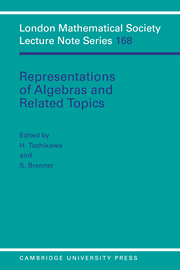Book contents
- Frontmatter
- Contents
- Introduction
- Homologically finite subcategories
- Global generatedness version of rings of pure global dimension zero
- Projective resolutions and degree shifting
- Modules of finite length over their endomorphism rings
- Pairs of semi-simple algebras (hereditary algebras with radical-square zero)
- The module theoretical approach to quasi-hereditary algebras
- Matrix problems, small reduction and representations of a class of mixed Lie groups
- Classification problems for modular group representations
- Lie algebras (arising in representation theory)
Modules of finite length over their endomorphism rings
Published online by Cambridge University Press: 05 August 2013
- Frontmatter
- Contents
- Introduction
- Homologically finite subcategories
- Global generatedness version of rings of pure global dimension zero
- Projective resolutions and degree shifting
- Modules of finite length over their endomorphism rings
- Pairs of semi-simple algebras (hereditary algebras with radical-square zero)
- The module theoretical approach to quasi-hereditary algebras
- Matrix problems, small reduction and representations of a class of mixed Lie groups
- Classification problems for modular group representations
- Lie algebras (arising in representation theory)
Summary
Given a ring R (associative, with 1) one can define the endolength of an R–module M to be its length when it is regarded in the natural way as an EndR (M)–module, and thus one can consider the class of modules of finite endolength. The aim of this paper is to show that this is a useful concept. Briefly, the contents are as follows. In §§1–3 we cover some background machinery, in §§4–6 we discuss the modules of finite endolength for a general ring, and in §§7–9 we show how these modules control the behaviour of the finite length modules for noetherian and artin algebras. Although much of this paper has a survey nature, there are some new results proved here, the main ones being the characterization of the pure-injective modules which occur as the source of a left almost split map in §2, the character theory for modules of finite endolength in §5, and the characterization of the artin algebras with an indecomposable module of infinite length and finite endolength (a generic module) proved in §§8–9.
The author is supported by an SERC Advanced Research Fellowship. I would like to thank M. Prest and A. H. Schofield for some useful discussions.
THE FUNCTOR CATEGORY
If R is a ring, we denote by R–Mod the category of left R–modules, and by mod–R be the category of finitely presented (f.p.) right R–modules. We denote by D(R) the category of additive functors from mod–R to ℤ–Mod (the category of abelian groups). This category has a very rich structure, and is an invaluable tool for the study of R–modules.
- Type
- Chapter
- Information
- Representations of Algebras and Related Topics , pp. 127 - 184Publisher: Cambridge University PressPrint publication year: 1992
- 33
- Cited by



